Maximize Your Chances of Harvesting a Large Mature Bear
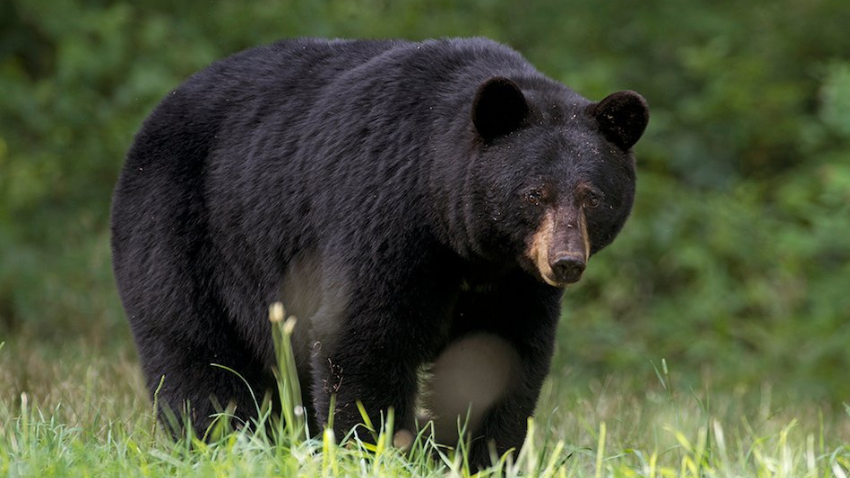
In this blog, Daniel Larocque, who has 25 years of experience as a guide, shares tips to increase your chances of harvesting a mature bear during your hunts. Discover how to choose the location of your hunting stand, adapt your approach, and much more for a successful spring bear hunting experience.
Is there anyone among you who, like me, has taken an eternity to decide on the location of a treestand or a ground blind? Especially when you have two or three hunting friends who get involved by giving their opinions. The discussions go like this: he could come from there, not many shooting opportunities, the tree is not big enough, how to arrive and leave without causing too much damage, etc.
Before considering the location of the hunting stand and baiting site, here are some tips to maximize your chances of harvesting a mature bear.
It's clear that if there are bears in your area, and since they are gluttonous, no matter where you place your bait, they will show up. Hopefully during the day but certainly at night. Here are some details that can make a difference and maximize daytime activity.
Over the years, I have prepared several bait sites for spring bear hunting in all kinds of habitats. The first year, in 1998, I had the chance to guide 23 clients from the United States for an outfitter.
Bait activity results varied greatly depending on the chosen locations. In some places, bears would take a few bites of food and run into the undergrowth to repeatedly pass by for other small bites.
The outfitter tended to set up his baits in small clearings located in very dense coniferous forests. With no visibility for both the hunter and the bear.
Another factor complicating matters was that the wind constantly swirled, and the hunters were continually smelled by the bears.
However, there were baits with a lot of daytime activity. The arrival of surveillance cameras allowed me to learn a lot about the ghost of our forests and why some baits were visited much more than others.
We are aware that bears have a very well-developed sense of smell, respectable hearing, but lesser vision.
Good field of vision
To contribute to the bear's comfort, look for a place where it will have a good field of vision, so it can see its friends coming!
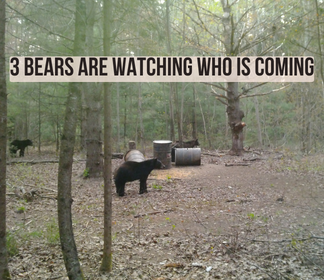
When I say field of vision, I don't mean in the middle of a field or a clearing. To date, my winning recipe is a mature forest with a fairly clear undercover with the presence of mature conifers. If there are no conifers, the bear will feel less secure until the leaves have grown a bit.
On average, I like to see up to 70 yards depending on the angles. So, early in the season, it will look bare, but the leaves will quickly make up for it.
Be vigilant about outdoor temperature
As spring hunting begins in mid-May and can extend until the end of June, you will be hunting in temperatures sometimes reaching 30 degrees Celsius. So, speaking of heat... be vigilant and make sure you have your own cold room like the Coolbot system or have a butcher open until the wee hours of the morning and has room!
Here is the importance of having conifers that form shaded areas to maximize the movement of bears still wearing their winter coats. This will also protect you from the scorching sun during your hunting trips.
Safety and emergency exit
Another very important detail is to find a place where there are a few mature trees within 10-15 feet (3 to 5 meters) of the bait so that smaller bears have an emergency exit. It is always better to have bears at the barrel even if they are small. This will comfort the larger ones watching from afar and potentially encourage them to approach.
A quiet place
Avoid active swamps, as all you will hear besides billions of mosquitoes will be frogs and bullfrogs.
This applies to both rapids and streams that make too much noise for you to hear anything, and I've noticed that bears don't feel safe when they can't hear.
Location of your ground blind or treestand
Once you think you have finally found the ideal location to place the bait, you need to make sure you can set up your treestand or ground blind first. If you opt for a ground blind, make sure you can control the comings and goings of the bears. Position yourself in a location where the likelihood of bears coming up behind you is lower, such as an agricultural field, a large clearing, a cliff, or a body of water.
A priority before making your final installation is to choose which wind you want to hunt in. I strongly suggest opting to hunt with West, Southwest, and/or Northwest winds, as they are predominant during this time of the year. Otherwise, you will probably hunt on rainy and cool days, which are not favorable for bear hunting.
Also, it's important to hunt downwind. With all these efforts, don't make the mistake of showing up at your hunting site when the wind is not in your favor. A bear will smell you from far away.
The sense of smell in bears is incredibly sharp and is considered one of their most important senses. It is estimated that a bear's sense of smell is 7 times better than that of a dog and about 100 times more powerful than that of a human. They can detect odors several kilometers away, depending on factors such as wind direction, humidity, and odor strength. This exceptional olfactory ability helps bears locate food, identify other bears, and avoid potential dangers.
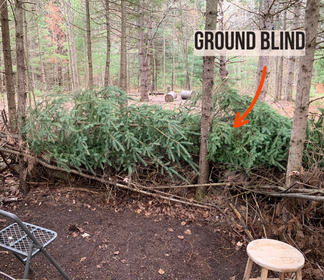
Protect yourself from mosquitoes and the sun
We agree that bear hunting means mosquitoes and that we are dressed from head to toe to avoid bites. Fortunately, devices like Thermacell and Watkins mosquito repellent cream exist to make our hunting trips more tolerable.
Facing west clearly indicates that you will have the sunset in your face until the leaves come out. I return to the importance of conifers. Use their shade. Set up your ground blind or treestand, taking into account the path of the sunset. I always arrange to be as little exposed to the sun as possible and, if possible, not at all. This keeps me cool and prevents the sun from blinding me during its long, eternal spring setting. The bonus is that the cooler we are, the less mosquitoes bother us.
Before proceeding to bait the barrel, complete the installation of your ground blind or treestand. I hunt bears on the ground because I find it much easier to arrive and leave my blind without being detected by bears.
Your safety first
Remember that I have spent hundreds of hours in the presence of bears around me and that I know their behavior. I am always armed with cayenne pepper as a preventive tool. A mother bear with her cubs can be very aggressive in protecting her little ones.
Plan your approach
To do this, on the day of site preparation, I rake the last 300 feet before arriving at the blind. So once it's done, there's only beautiful black soil left, allowing me to arrive and leave without alerting the bears.

I would say that 80% of the time, whether upon my arrival or departure, there is a bear at the barrel. This is the beauty of hunting on the ground. Climbing up or down a treestand without being detected is not easy.
Approximately 60 meters before arriving at the blind, I start another trail that forks towards the bait. I never walk between the bait and my blind to avoid detection as much as possible. Especially if a female accompanied by her cubs is present. The goal is to avoid stressing her and having to defend myself.
Where to place your bait
Position the barrel securely attached to a tree at the highest point of the area to maximize the bear's field of vision. Even if the mound is only 8 inches higher than the rest of the bait location's radius, the bear will be much more comfortable and will often allow itself to stretch and stuff its belly to the limit before a more dominant bear gets too close.
And finally, make sure you have quality bait so that bears will want to come back and feed. The bait I use comes in boxes containing a mix of grains, molasses, and dried fruits, weighing about 70 lbs/32 kg.
I bait generously at the beginning of the season to attract and retain as many bears as possible in the area, increasing my chances of attracting dominant individuals to come and check it out.
Your surveillance cameras
One of the biggest challenges is also the installation and positioning of one or more surveillance cameras at the bait site.
A little trick I've adopted to prevent bears and raccoons from moving or simply destroying my cameras is to use a 4-6 inch diameter tree as a pole. I choose a tree of this size that I will pass by each time I go to fill the barrel. I climb directly onto the luggage rack of my ATV and cut the tree about ten feet from the ground to then install my camera(s).
With this technique, I prevent bears and raccoons from climbing to seek refuge from predators. From this point on, every time I go to feed, I can retrieve the cards from my cameras without setting foot on the ground and then continue on my ATV to the bait site to proceed with the baiting.
Conclusion
Carefully choosing the location of your treestand and baiting site, taking into account the tips mentioned, is essential to increase your chances of harvesting a mature bear. Consider the animal's field of vision, the comfort and safety it feels, as well as the positioning of the surveillance cameras.
Don't forget to take into account weather conditions and terrain features to ensure a more enjoyable and effective hunt. By putting these tips into practice and being attentive to the needs and behavior of bears, you can have a successful and memorable spring bear hunting experience.
Happy hunting!
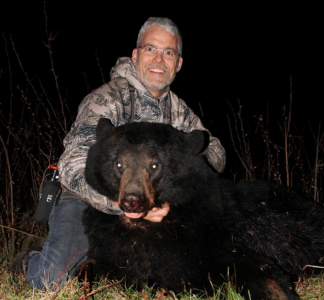


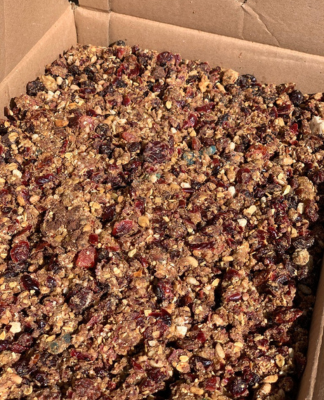
Comments
Be the first to comment...